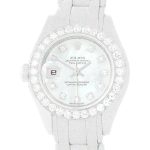Why the Rolex Day-Date’s Gold and Platinum Models Stand Out
When I think about luxury watches, the Rolex Day-Date instantly comes to mind. This iconic timepiece has been a symbol of success and prestige since its introduction in 1956. What truly sets the Day-Date apart are its gold and platinum variants, which not only elevate the watch’s status but also offer unique characteristics that appeal to collectors and enthusiasts alike. Each metal brings its own personality, making the choice between them an intriguing one.
White Gold vs. Platinum: How to Tell the Difference
At first glance, white gold and platinum might appear similar, but once you examine them closely, the differences become clear. White gold is an alloy, typically made with yellow gold mixed with metals like palladium or nickel, which gives it a bright finish. In contrast, platinum is a naturally white metal, denser and heavier than gold. When I hold a platinum Day-Date, I can feel its substantial weight, which speaks to its quality. Additionally, platinum has a slightly warmer hue compared to the cooler tone of white gold.
Another distinct feature is the hallmarking. Platinum pieces are stamped with “PT” or “950” to indicate their purity, while white gold usually carries a mark of “750” or “18K.” If you’re keen on details, these markings can help you identify which metal you’re dealing with.
The Appeal of Rose Gold: A Modern Take on a Classic
Rose gold has gained immense popularity in recent years, and it’s easy to see why. Its warm, pinkish hue adds a contemporary flair to the classic design of the Day-Date. I find that rose gold complements a wide array of skin tones, making it a versatile choice for both men and women. What’s fascinating is that the color comes from the addition of copper to the gold alloy, which gives it that distinctive rosy tint.
The aesthetic of rose gold is not just about looks; it also evokes a sense of warmth and elegance. When I wear a rose gold Day-Date, I feel it captures a perfect balance between modernity and tradition, making it an excellent option for those who want something that stands out without being overly flashy.
The Durability of Platinum vs. Gold: Which Lasts Longer?
When it comes to longevity, platinum takes the crown. It’s highly resistant to scratches and tarnishing, which means a platinum Day-Date will maintain its pristine appearance over time, even with daily wear. I appreciate that platinum develops a natural patina that many enthusiasts find appealing, giving the watch a unique character as it ages.
Gold, while beautiful, is softer than platinum and can scratch more easily. However, the added alloy metals in white gold can enhance its durability to some degree. Still, I always recommend platinum for someone looking for a watch that can withstand the test of time without losing its charm.
How Gold and Platinum Affect the Price of a Replica
The choice of metal significantly impacts the price of a replica Rolex watch Day-Date. Platinum, being a rarer and more expensive material, typically commands a higher price than gold variants. When I compare the costs, I notice that even within gold models, the price can vary based on whether it’s yellow, white, or rose gold, with rose gold often sitting at the higher end due to its popularity.
As you ponder the investment, it’s crucial to consider both the aesthetic appeal and the potential value retention. A well-maintained platinum replica can be a worthy investment, while gold models may offer more versatility in terms of styling.
Which Rolex Day-Date Metal Works Best for Everyday Wear?
For everyday wear, I find that the choice between gold and platinum really depends on your lifestyle and personal preferences. If you lead an active lifestyle and want something that can handle the occasional bump or scratch, platinum is your best bet. Its robustness and resistance to wear make it an ideal daily companion.
However, if you prefer a watch that offers a classic look and can seamlessly transition from day to night, a gold variant, particularly yellow or rose gold, is excellent. They have a certain warmth and elegance that can enhance any outfit, whether casual or formal.
Rarity and Exclusivity: Limited Edition Gold and Platinum Models
When you dive into the world of Rolex, the limited edition gold and platinum models truly stand out. These pieces often come with unique features or special engravings that set them apart from the standard offerings. I’ve seen limited editions with unique dials or even special packaging that collectors crave.
The rarity of these models not only adds to their exclusivity but can also significantly increase their value over time. If you’re fortunate enough to come across a limited edition Day-Date, it’s worth considering as a long-term investment and a centerpiece of your collection.
The Most Sought-After Gold and Platinum Rolex Day-Date References
Some references in the Rolex Day-Date lineup have gained legendary status among collectors. The reference 1803, for instance, is a classic that collectors often seek out, particularly in gold variants. On the platinum side, the reference 218206, with its distinctive ice-blue dial, is incredibly sought after.
Each reference has its own story and appeal, making them not just watches but pieces of history. As I explore these references, I can’t help but appreciate the craftsmanship and heritage behind each model, which adds to their desirability.
Choose the Right Metal Based on Your Style
Ultimately, the choice between gold and platinum comes down to personal style and how you envision wearing your watch. If you gravitate towards the classic, timeless appeal, yellow gold might be your go-to. If you prefer something a bit more modern and trendy, rose gold could be your match. For those who value durability and a sense of understated luxury, platinum is the way to go.
As you consider your options, think about how each metal aligns with your lifestyle and fashion preferences. After all, the right watch should not only tell time but also reflect who you are.
Yellow Gold vs. White Gold vs. Rose Gold: What’s the Difference?
As we delve deeper into gold variants, it’s essential to understand the distinctions between yellow, white, and rose gold. Each type offers a unique aesthetic and feel, which can significantly influence your choice of a Rolex Day-Date.
White Gold vs. Platinum: How to Tell the Difference
In the ongoing comparison of white gold and platinum, we see that while both offer a beautiful, sophisticated look, their practical differences are significant. White gold’s lighter weight and alloy composition mean it can wear differently on the wrist compared to the heft of platinum.
Furthermore, the finish can differ; white gold often has a rhodium plating that can wear off over time, requiring occasional re-plating to maintain its luster, while platinum’s finish is more enduring. When I wear a white gold Day-Date, I’m conscious of its maintenance compared to the low-key upkeep of a platinum piece.

